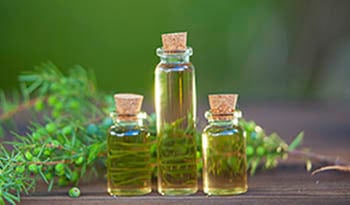How to Fight Acne Naturally
OŚWIADCZENIENiniejszy blog nie ma na celu diagnozowania...

If there’s one medical issue that afflicts teenagers and young adults more than any other, that condition is acne vulgaris, the medical term for acne or, simply, the condition of having too many pimples. Acne is caused by excess sebum—an oily secretion produced by the skin’s sebaceous glands—and dead skin cells that block up hair follicles. The result is “breakouts” that often appear on the face, but can also pop up on the neck, back, chest and shoulders.
Why do some people suffer from acne while others maintain clear skin throughout puberty and young adulthood? There are numerous reasons, but genetics play a big role along with exposome—the sum of one’s environmental exposures, including nutrition, lifestyle, occupational conditions, pollutants, medications taken, and climate.
In general, boys tend to be more affected by acne than girls, but the condition can be devastating for anyone who must contend with it. Elevated testosterone levels, as experienced by boys during puberty, may be to blame while insulin resistance and pre-diabetes also increase the risk. Though boys may be more affected during the teen years, some women are affected well beyond the teen years with hormonal acne triggered by the menstrual cycle and conditions like polycystic ovarian syndrome.
While most cases of acne are treated by a patient’s primary care doctor or pediatrician, sometimes patients are referred to a dermatologist for more aggressive treatment options, including topical and oral medications, like retinoids, acids, birth control pills and antibiotics. Fortunately, there are also some non-medication approaches one can take to decrease acne no matter what age you are.
Remove Toxins
There are a few things you can do to help remove toxins from your body. Cleaning up your diet, avoiding processed foods, removing mercury from your mouth, improving gut health, healing the liver and optimizing kidney function can all improve your overall health, and ultimately, your skin. Tobacco smoking also appears to be a risk factor for acne—vaping included.
Clean up Your Diet
Studies show dairy products, like milk, increase production of sebum by stimulating the IGF-1 hormone and, therefore, increase acne risk. Further, high intake of foods with omega-6 acids, specifically the refined vegetable oils and soy oils used in processed foods, are a risk factor for acne. High-sugar foods are also believed to contribute to the condition, so minimizing them is advised.
Focusing on a well-balanced eating plan is crucial. Some things to consider:
- Chocolate intake increases the likelihood of acne.
- Increasing vegetables in the diet can reduce acne.
- Consumption of cow’s milk increases the risk of acne.
- Foods with adequate levels of vitamins A and E and zinc can help prevent acne.
Additionally, good hydration is crucial to help remove toxins from the body, so make sure you’re drinking enough water throughout the day.
Improve Gut Health
Like many health conditions, gut health plays a big role in the presence or absence of other health conditions. Hippocrates stated 2,400 years ago that “all disease begins in the gut”. If gut health is not optimal, the results can manifest as skin conditions. I personally have seen cases of eczema, psoriasis, rashes, and acne improve when patients focus on digestive health. This is achieved by avoiding foods that one is sensitive to and increasing the gut’s good bacteria.
Our intestines are the primary way toxins enter our body. Those with gut issues, like irritable bowel syndrome, chronic diarrhea, constipation, bloating, etc., frequently cause a condition called leaky gut. A poor intestinal barrier results in increased absorption of chemicals and toxins.
Gut health can be optimized by taking quality probiotics and prebiotics while eating a diet high in fruits and vegetables. This is imperative for developing a healthy gut microbiome, which will ultimately help improve overall skin health.
Supplements Used for Acne
Omega-3 Fatty Acids
Omega-3 fatty acids are known for being in fish oil, but there are also non-animal sources of this essential fatty acid. Consisting primarily of eicosapentaenoic acid (EPA) and docosahexaenoic acid (DHA), these fatty acids are essential for muscle, brain and vascular health. A 2014 study in Nutrition Journal showed that the majority of Americans and others around the world do not consume enough essential fatty acids in their diet. Teenagers also lack adequate intake. These important nutrients can be found in a variety of fish and in other food sources, such as walnuts, chia seeds, flax seeds, hemp seeds, avocado, and natto.
Omega-3 fatty acids are beneficial for acne reduction at doses of 2,000 mg per day, according to a 2014 study. Similarly, a 2012 study showed that omega-3 fatty acids could help reduce the inflammation associated with moderate to severe acne. Suggested dose: 2,000 mg daily.
Zinc
A 2013 study in The Journal of Drugs in Dermatology demonstrated that oral and topical zinc could be helpful against acne due to its antibacterial and anti-inflammatory properties. In addition, a 2017 study in Dermatologic Therapy stated, “ Zinc is a promising alternative to other acne treatments owing to its low cost, efficacy, and lack of systemic side effect.” Suggested dose: 30 mg once to three times per day for up to 3 months.
Niacin
Vitamin B3 can be found in two different forms—the first is niacin (also known as nicotinic acid), and the second is niacinamide (also known as nicotinamide). In either form, vitamin B3 is a precursor to nicotinamide adenine dinucleotide (NAD), which plays a vital role in helping mitochondria—the cell’s powerhouse—create energy.
Topical niacin is believed to be helpful for those with skin conditions, including acne, according to a 2014 study. A 2017 study in Dermatologic Therapy also confirmed topical niacinamide’s usefulness in those with acne.
Vitamin C
Vitamin C is a potent antioxidant with many health benefits. Topical vitamin C can be beneficial in both the prevention and treatment of acne, according to a 2005 study in the International Journal of Cosmetic Science. Suggested dose: As advised on the label.
Vitamin D
In my Southern California medical practice, a place where we have sunny skies more than 300 days per year, four in five (80 percent) of my patients have clinical vitamin D deficiency, defined by a blood level 30 ng/ml (75 nmol/L) or lower. The reason for this common deficiency is that few people spend the required 15 to 20 minutes each day in the sunlight, allowing their face, arms and legs to be exposed to the ultraviolet light. Up to 90 percent of people around the world are deficient.
A 2015 study showed low levels of vitamin D were associated with increased acne while a 2016 study concluded: “Vitamin D deficiency was more frequent in patients with acne, and serum 25(OH)D levels were inversely correlated with acne severity, especially in patients with inflammatory lesions”. However, a 2018 study showed conflicting results. More studies are needed. Suggested dose: 2,000-5,000 IU daily.
NAC
N-Acetyl Cysteine (NAC) is a nutritional supplement. When present in adequate quantities, it helps protect the liver from toxins, such as acetaminophen (paracetamol), alcohol and other environmental chemicals. NAC works by helping the body build intracellular levels of the glutathione, a potent antioxidant. Thereby, it plays an important role in helping eliminate toxins from the liver, using the phase 2 pathway. A 2012 study showed that topical NAC could help reduce acne. Suggested dose: 500 to 1,000 mg per day.
Vitamin E
According to studies, vitamin E, when taken in conjunction with zinc and lactoferrin, reduces acne. Studies also show that low levels of vitamin E appear to be more common in those with acne. The fat-soluble vitamin is frequently used topically to help with skin appearance. Suggest dose: As directed on the label.
Probiotic
Studies have shown that a leaky gut, or disruption in the diversity of intestinal bacteria, increases not only systemic inflammation but can also the risk of acne. Use of antibiotics or acid reducers, in addition to a poor diet, can negatively affect gut bacteria, resulting in increased inflammation, as measured by CRP. According to studies, optimizing the gut microbiome may help reverse acne. Cultured foods such as natto, sauerkraut, kefir and kombucha tea may help. Suggested dose: Probiotic supplement 5 billion to 60 billion units daily
Other supplements which may be helpful include pantothenic acid, vitamin A, selenium and possibly, vitamin B6.
A Holistic Approach to Acne
Preventing and treating acne can be complex. However, a holistic approach is necessary in order for one to achieve optimal success. Dietary changes are crucial, and the elimination of toxins is also helpful. Medications can be effective, however, it is recommended that they be used for the shortest amount of time possible, especially oral antibiotics. Optimizing nutrition and healthy living is key.
References:
- Capitanio B, Sinagra JL, Ottaviani M, Bordignon V, Amantea A, Picardo M. Acne and smoking. Dermatoendocrinol. 2009;1(3):129-35.
- Pol Merkur Lekarski. 2017 Oct 23;43(256):186-189.
- Cutis. 2011 Aug;88(2):84-91. (High sugar foods and acne)
- Clark AK, Haas KN, Sivamani RK. Edible Plants and Their Influence on the Gut Microbiome and Acne. Int J Mol Sci. 2017;18(5):1070. Published 2017 May 17. doi:10.3390/ijms18051070
- Int J Dermatol. 2016 May;55(5):587-91. doi: 10.1111/ijd.13188. Epub 2015 Dec 29.
- Clin Nutr. 2018 May 8. pii: S0261-5614(18)30166-3. doi: 10.1016/j.clnu.2018.04.015 (milk and acne)
- Cutan Ocul Toxicol. 2014 Jun;33(2):99-102. doi: 10.3109/15569527.2013.808656. Epub 2013 Jul 5.
- Papanikolaou Y, Brooks J, Reider C, Fulgoni VL. U.S. adults are not meeting recommended levels for fish and omega-3 fatty acid intake: results of an analysis using observational data from NHANES 2003–2008. Nutrition Journal. 2014;13:31. doi:10.1186/1475-2891-13-31.
- Acta Derm Venereol. 2014 Sep;94(5):521-5. doi: 10.2340/00015555-1802. (omega 3 and acne)
- Khayef G, Young J, Burns-Whitmore B, Spalding T. Effects of fish oil supplementation on inflammatory acne. Lipids Health Dis. 2012;11:165. Published 2012 Dec 3. doi:10.1186/1476-511X-11-165
- J Drugs Dermatol. 2013 May;12(5):542-5.
- Dermatol Ther. 2017 Nov 28. doi: 10.1111/dth.12576. [Epub ahead of print]
- J Cosmet Dermatol. 2014 Dec;13(4):324-8. doi: 10.1111/jocd.12119. (niacin and acne)
- Dermatologic Therapy. 2017 Sep;30(5). doi: 10.1111/dth.12481. Epub 2017 Feb 21.
- Int J Cosmet Sci. 2005 Jun;27(3):171-6. doi: 10.1111/j.1467-2494.2005.00263.x.
- Toossi P, Azizian Z, Yavari H, Fakhim TH, Amini SH, Enamzade R. Serum 25-hydroxy vitamin D levels in patients with acne vulgaris and its association with disease severity. Clin Cases Miner Bone Metab. 2015;12(3):238-42.
- Lim SK, Ha JM, Lee YH, et al. Comparison of Vitamin D Levels in Patients with and without Acne: A Case-Control Study Combined with a Randomized Controlled Trial. PLoS One. 2016;11(8):e0161162. Published 2016 Aug 25. doi:10.1371/journal.pone.0161162
- Al-Taiar A, AlKhabbaz M, Rahman A, Al-Sabah R, Shaban L, Akhtar S. Plasma 25-Hydroxy Vitamin D is not Associated with Acne Vulgaris. Nutrients. 2018;10(10):1525. Published 2018 Oct 17. doi:10.3390/nu10101525
- Fundam Clin Pharmacol. 2018 Nov 24. doi: 10.1111/fcp.12437. (NAC and Acetaminophen)
- Skinmed. 2012 Nov-Dec;10(6):348-51. (topical NAC and acne)
- Int J Dermatol. 2017 Jun;56(6):686-690. doi: 10.1111/ijd.13607. Epub 2017 Mar 30.
- Cutan Ocul Toxicol. 2014 Jun;33(2):99-102. doi: 10.3109/15569527.2013.808656. Epub 2013 Jul 5.
- O'Neill AM, Gallo RL. Host-microbiome interactions and recent progress into understanding the biology of acne vulgaris. Microbiome. 2018;6(1):177. Published 2018 Oct 2. doi:10.1186/s40168-018-0558-5

 Wg Dr. Eric Madrid, M.D.
Wg Dr. Eric Madrid, M.D.


